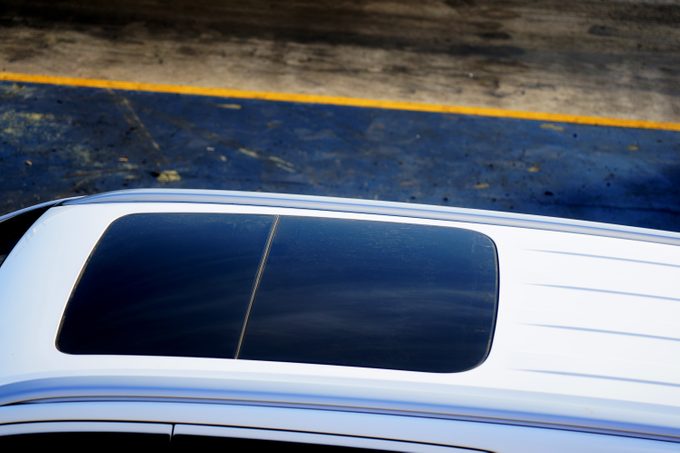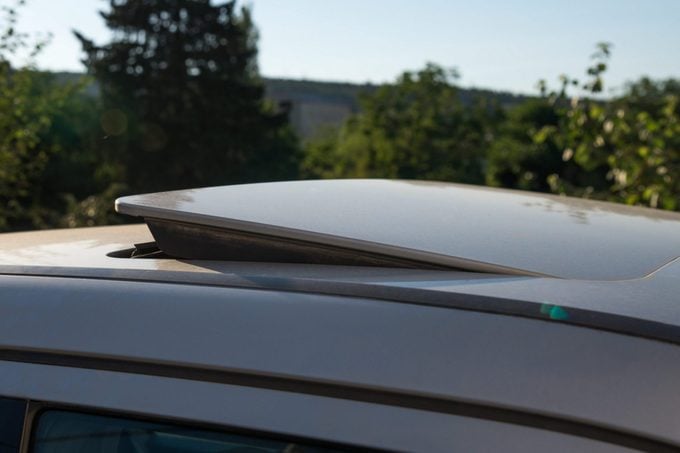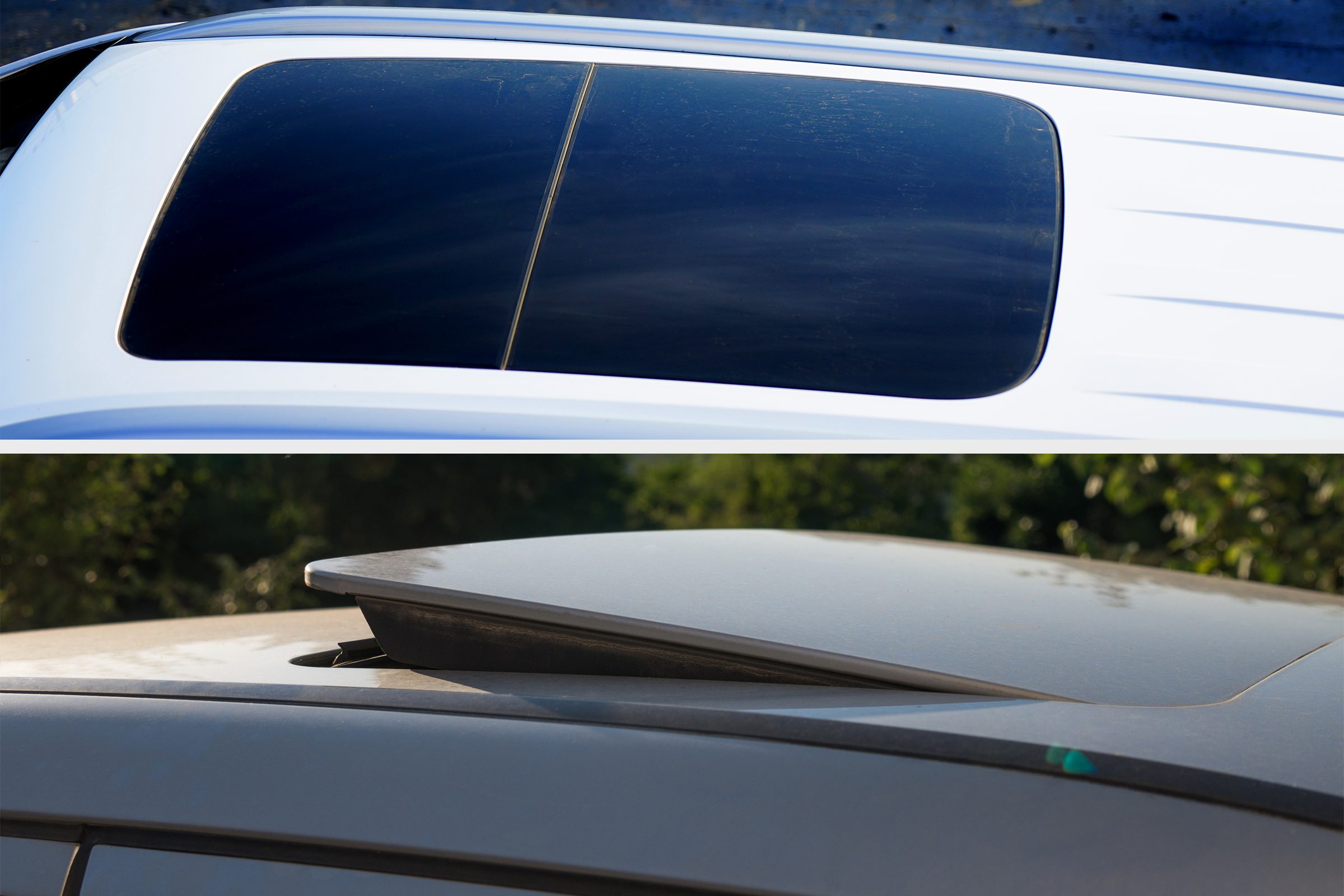The first horseless carriages were open air cars and more of a curiosity than a mode of transportation. After World War I, closed-body cars became less expensive to build. By the early 1920s, closed-body motor vehicles became the dominant form of transportation in cities and towns across America.
But with drivers still yearning for the feel of the open road, sliding “sunshine” roofs were introduced in the late 1920s. The 1950s and 60s were the heyday for convertibles, and sunroofs fell out of fashion.
During the 1970s, however, effective factory air conditioning, strict government rollover regulations and auto construction economics led to the demise of most convertible models. That drove the demand for sunroofs and moonroofs. Today the terms are used interchangeably, but there are distinct differences.
What’s the Difference Between a Sunroof and a Moonroof?
- Sunroofs can be popped open or removed. Originally they were a solid panel, painted the same color as the body. Modern versions and aftermarket installations are made from glass or acrylic sheet.
- Historically, a moonroof was a fixed transparent panel. Today’s moonroofs are tinted glass panels that slide on a track system, operated by motor-driven cables.
- Moonroofs come with a built-in manual or power-operated retractable sunshade or panel that helps reduce interior heat levels.
- Unlike a sunroof, moonroofs let light in the passenger compartment even when closed.
- Moonroofs are larger than sunroofs.
- Thieves can easily break a glass moonroof, whereas a solid panel sunroof is less likely to break.
- The cost of a factory-installed moonroof averages about $1,500, while a pop-up sunroof averages about $650.
- The cost to repair or replace damaged moonroof drive cables or the motor, depending on the vehicle and trim, can cost $1,000 or more.
Pros and Cons of a Moonroof
 Supersmario/Getty Images
Supersmario/Getty Images
Pros
- Fresh air and sunshine from an open moonroof can make you feel happier and more carefree.
- Provides an infinite look at the sky, even when closed.
- Feeling of being in a convertible with less chance of sunburn or messing your hair.
- Provides more safety and security than a fabric convertible top.
- Visually satisfying addition to any vehicle.
- May increase the resale value of your vehicle.
Cons
- Expensive to install and repair.
- Mechanical assembly reduces headroom.
- Additional weight can affect handling and reduce fuel economy.
- Prone to leakage from bad seals or clogged drain tubes.
Pros and Cons of a Sunroof
 goglik83/Getty Images
goglik83/Getty Images
Pros
- Offers improved views of your surroundings when open.
- Increased airflow when all windows are lowered, limiting the need for the AC on summer days.
- Better cell phone reception.
- Provides better security than a glass moonroof or fabric convertible top.
- Less expensive to install or repair than a moonroof.
- Does not affect headroom.
- May increase the resale value of your vehicle.
Cons
- Noisy from air turbulence.
- Solid panels block view of the sky when closed.
- Must store in trunk when removed.
- Prone to leakage from bad seals.
Sunroof Installation
If your car or truck didn’t come with a moonroof or sunroof, DIY kits and specialty shops can add a sunroof or moonroof to your vehicle, depending on your make, model and year.
Our advice: Leave this to the pros.
The roof of any vehicle is an integral structural component. Cutting a hole in the roof weakens the entire body assembly, especially when cutting cross-support beams welded to the underside of a roof panel. Installing a power sliding moonroof requires adding additional wiring, electronics, relays and likely extensive body repairs. Think long and hard before taking this on, and defer to the pros if you’re even slightly unsure.
However, if you’re willing to give it a go, here are the basic steps to install a pop-up sunroof:
- Measure the roof and find a kit that is an exact fit for your vehicle.
- Wear eye protection. This is NOT optional.
- Remove any trim securing the headliner (the material that covers the ceiling), the headliner itself, wires, lamps or electronics and anything else hidden behind the headliner.
- Cover the roof with painter’s tape.
- Place the kit’s cutout template on the roof and determine exactly where you want the sunroof positioned (usually over the front seat) and tape the ends to hold it in place.
- Carefully trace around the template with an exacto knife, cutting into the tape. Don’t cut into the paint.
- Drill one-quarter-inch holes at the four corners, about an inch inside the line you scribed on the tape. Beware: Once you drill the holes, you are at the point of no return!
- Slowly and carefully cut along the line using a jigsaw or nibbler tool (preferred).
- Wearing work gloves, carefully remove the cut panel. The edges of the sheet metal will be sharp.
- Remove any pieces of leftover metal. Smooth the edges with a file to remove any burrs, sharp or jagged edges.
- Sand, clean and rustproof any exposed metal with primer. Once dry, spray on a coat of clear coat to protect the exposed metal from rusting. Let the primer and clear coat fully dry.
- Depending on the kit, the weather seal may or may not be attached to the roof assembly. Follow the manufacturers instructions if the seal needs to be installed separately.
- Remove the sunroof panel from the frame.
- Once the seal is in place, drop in the outer roof assembly/frame into the prepared hole.
- From inside the car, slide the lower support inner frame into the outer frame. Attach with the supplied hardware.
- If your kit came with adhesive strips to secure the headliner, install them now. Don’t remove the protective covering on the side facing you.
- Reinstall the wires, electronics and anything else removed from behind the headliner.
- Reinstall the headliner and carefully trim around the newly installed sunroof.
- Once you have the headliner fitted correctly, remove covering protecting the adhesive strips.
- Carefully secure the headliner to the adhesive strips.
- Reinstall trim, wires, lamps, electronics, etc.
- If the kit came with finishing trim, install it now.
- Place the sunroof panel into the assembly and check for leaks.
The Final Word
Sunroofs and moonroofs are a nice accessory. To keep them working properly, vacuum and clean the tracks regularly. Lubricate any moving parts with dry lube. To help prevent problems, clean the drain channels and seals with a clean cloth at least once a year.
Clean the drain tube openings (located at the four corners of the sun or moonroof) using a soft one-eighth-inch plastic tube or pipe cleaner. Once clear of debris, flush the drain tubes by slowly pouring a cup of water at a time in the drain channel. You’ll know the drain is open when the water starts dripping from underneath your vehicle.
ⓘ



